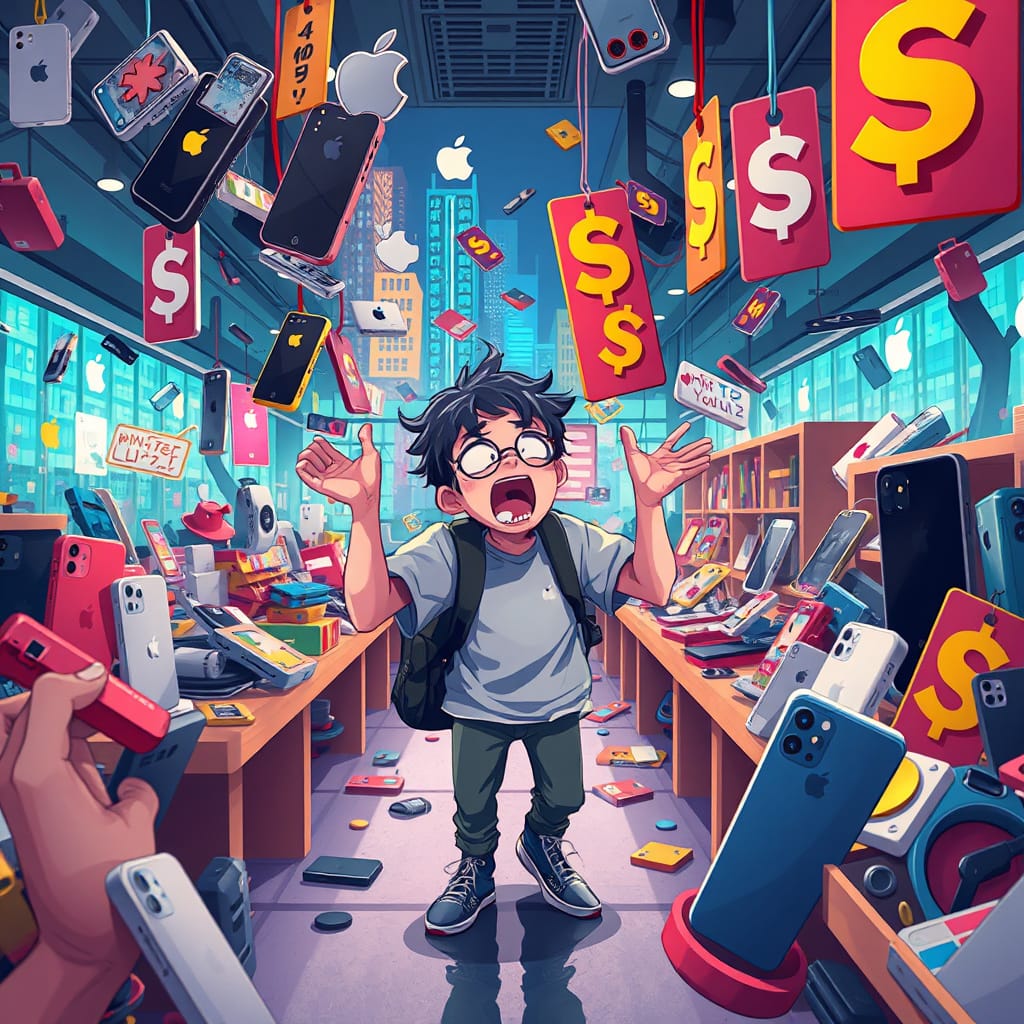It was the best of times for Apple shareholders, it was the worst of times for anyone who thought they understood how capitalism was supposed to work. In the gleaming towers of Cupertino, where executives in $700 hoodies contemplate the profound mysteries of profit margin optimization, a solution to the US-engineered tariff crisis emerged that was so audaciously cynical it could only have been conceived by minds unencumbered by shame or basic human decency.
The announcement came with the characteristic Apple fanfare: a carefully choreographed presentation where Chief Revenue Optimization Officer Miranda Sterling stood before a backdrop of minimalist white curves and declared that Apple had “reimagined the iPhone experience to empower users with unprecedented customization opportunities.” What she meant, in language comprehensible to those not fluent in corporate doublespeak, was that Apple had decided to make customers assemble their own phones while somehow charging them more for the privilege.
The genius of the plan lies not in its innovation—humans have been assembling electronics for decades—but in its breathtaking transformation of necessity into premium experience. Faced with tariffs that threatened to reduce their profit margins from “obscene” to merely “unconscionable,” Apple’s leadership team asked themselves a profound question: “How can we make our customers pay for our problems while convincing them they’re getting a deal?”
The Assembly Kit Revolution: Some Assembly Required, Dignity Sold Separately
The iPhone Assembly Experience, as Apple has branded it, represents the logical endpoint of the company’s decades-long journey toward extracting maximum value from minimum effort. For the low price of $1,299—a modest $200 increase over the previous fully-assembled model—customers can now purchase the iPhone 16 Assembly Kit, which includes all the components necessary to build their own device, along with a beautifully designed instruction manual that Apple describes as “intuitive” and early beta testers describe as “a psychological torture device disguised as technical documentation.”
The kit arrives in Apple’s signature minimalist packaging, which manages to make a box of loose electronic components look like a luxury gift. Inside, customers will find the iPhone’s logic board, display assembly, battery, camera modules, and approximately 47 screws of varying sizes, each requiring a different specialized tool that must be purchased separately through Apple’s new “Pro Assembly Toolkit,” available for the reasonable price of $399.
Dr. Rebecca Chen, Apple’s newly appointed Director of Customer Empowerment Through Self-Reliance, explained the philosophy behind the program during a recent press briefing. “We realized that our customers were missing out on the profound satisfaction that comes from creating something with their own hands,” she said, her expression maintaining the serene confidence of someone who has never assembled anything more complex than a British BLT sandwich. “The iPhone Assembly Experience transforms the act of purchasing a phone into a journey of personal growth and technical mastery.”
The journey, according to early adopters, typically begins with confidence and ends with existential despair. Marcus Rodriguez, a software engineer from Portland, Oregon, who participated in Apple’s beta testing program, described his experience with the characteristic thousand-yard stare of a combat veteran. “I spent fourteen hours trying to connect the display cable,” he recounted. “The instructions just said ‘gently insert connector until it clicks.’ It never clicked. Nothing ever clicks. I’m starting to think the clicking is a metaphor for something deeper.”
The Repair Kit Ecosystem: Breaking Things Has Never Been More Profitable
Not content with merely charging customers to assemble their own devices, Apple has created an entire ecosystem around the inevitable failures that result from amateur electronics assembly. The iPhone Repair Experience Kit, available for $299, includes replacement components for the most commonly damaged parts during assembly, along with a selection of tools that are almost, but not quite, the same as the ones needed for initial assembly.
The repair kit represents Apple’s commitment to what they call “circular customer engagement”—a business model where each attempt to fix a problem creates new problems that require additional purchases. The kit includes a replacement display (for when customers inevitably crack the original during installation), a new battery (for when the first one is installed backwards), and a selection of screws in sizes that are subtly different from the original kit, ensuring that customers who mix up components will need to purchase additional hardware.
“We’ve essentially gamified device ownership,” explained Apple’s Chief Innovation Officer, Dr. Amanda Foster, with the enthusiasm of someone describing a particularly clever chess move. “Each repair attempt is an opportunity for learning, growth, and additional revenue generation. It’s a win-win scenario, assuming you define ‘winning’ from our perspective exclusively.”
The repair ecosystem extends beyond simple component replacement. Apple has partnered with leading meditation apps to offer “Mindful Assembly” sessions designed to help customers achieve inner peace while struggling with microscopic connectors. The company has also launched a subscription service called “Assembly Zen,” which provides daily affirmations specifically tailored to the emotional challenges of consumer electronics assembly.
The Apple Logo Licensing Program: Identity as a Service
Perhaps the most audacious aspect of Apple’s new strategy is the Apple Logo Licensing Program, which requires customers who successfully assemble their devices to purchase the right to display the iconic Apple logo and qualify for AppleCare coverage. The program, which costs $199 annually, grants customers a small adhesive Apple logo and the legal right to call their assembled device an “iPhone” rather than a “collection of Apple-branded components arranged in phone-like configuration.”
The licensing program represents Apple’s recognition that their true product has never been technology—it’s identity. The Apple logo serves as a digital status symbol, a tribal identifier that signals membership in an exclusive club of people who are willing to pay premium prices for the privilege of doing work that was previously done by factory workers earning a fraction of minimum wage.
“The Apple logo is more than just a symbol,” explained Apple’s Director of Brand Monetization, Dr. Sarah Kim, during a presentation that felt like a TED talk delivered by someone who had never experienced genuine human emotion. “It’s a statement of values, a commitment to excellence, and a legally binding agreement to participate in our ecosystem of premium experiences and recurring charges.”
Customers who choose not to purchase Apple logo licensing can still use their assembled devices, but they forfeit access to AppleCare, the App Store, and what Apple terms “brand coherence support.” Their devices will display a generic fruit logo—specifically, a slightly sad-looking pear—and will be referred to in all Apple communications as “Compatible Assembly Units” or CAUs.
The Economics of Absurdity: How to Charge More for Less
The financial engineering behind Apple’s assembly kit strategy reveals a level of creative accounting that would make Enron executives weep with admiration. By shifting assembly costs to customers while simultaneously increasing prices, Apple has managed to improve their profit margins while technically reducing their manufacturing overhead. The company can now claim that their devices are “artisanally crafted” and “locally assembled,” since customers are doing the assembly in their own homes.
The strategy also provides Apple with a convenient scapegoat for quality control issues. Devices that malfunction can be attributed to “assembly variation” rather than design flaws, shifting liability from the manufacturer to the customer. Apple’s warranty now includes a clause stating that coverage is void if the device shows “evidence of non-optimal assembly techniques,” a category that apparently includes breathing on the components during installation.
Industry analysts have praised Apple’s strategy as a masterclass in customer relationship management. “They’ve managed to transform their biggest cost center—manufacturing—into a revenue stream,” noted tech economist Dr. Jennifer Walsh. “It’s like convincing people to pay you for the privilege of doing your job for you, except somehow making them feel grateful for the opportunity.”
The Human Cost of Innovation: When Customers Become Unpaid Employees
The broader implications of Apple’s assembly kit strategy extend far beyond the tech industry. The company has essentially created a new category of consumer: the paying employee. Customers now invest their own time, effort, and emotional energy into creating products that Apple then sells them, while taking no responsibility for the quality or functionality of the final result.
The psychological impact on customers has been profound. Support groups have emerged for people struggling with “Assembly Anxiety Disorder,” a condition characterized by the persistent fear that one has incorrectly installed a critical component. Apple has responded by offering a premium counseling service called “Genius Therapy,” where trained technicians provide emotional support for $149 per session.
The assembly kit phenomenon has also created a new form of social stratification. Successfully assembled iPhones have become status symbols that signal not just wealth, but technical competence and patience. Social media is filled with #assemblyflex posts, where users display their completed devices alongside the tools and emotional support systems that made their achievement possible.
The Future of Self-Service Premium Products
Apple’s success with iPhone assembly kits has inspired other premium brands to explore similar strategies. Tesla has announced plans to sell “Automotive Assembly Experiences” where customers can build their own electric vehicles in their driveways. Rolex is reportedly developing a “Timepiece Crafting Journey” that allows customers to assemble luxury watches using components that may or may not be properly calibrated.
The trend represents a fundamental shift in the relationship between manufacturers and consumers. Companies are discovering that customers will pay premium prices for the privilege of doing work that was previously considered a cost center. It’s a business model that combines the worst aspects of capitalism with the most exploitative elements of the gig economy, wrapped in the language of empowerment and personal growth.
As Apple continues to refine their assembly kit strategy, rumors suggest that future products will require even more customer involvement. The iPhone 17 Assembly Kit is expected to include raw silicon wafers that customers must process into chips using equipment available through Apple’s “Semiconductor Crafting Experience.” The iPhone 18 may require customers to mine their own rare earth elements, though Apple assures potential buyers that they will provide detailed geological surveys for an additional fee.
Have you experienced the joy of assembling your own premium electronics, or are you still clinging to the outdated notion that products should arrive functional? Share your assembly horror stories or triumphs below—misery loves company, and apparently so does Apple’s customer service department.
Enjoyed this dose of uncomfortable truth? This article is just one layer of the onion.
My new book, “The Subtle Art of Not Giving a Prompt,” is the definitive survival manual for the AI age. It’s a guide to thriving in a world of intelligent machines by first admitting everything you fear is wrong (and probably your fault).
If you want to stop panicking about AI and start using it as a tool for your own liberation, this is the book you need.
>> Get your copy now (eBook & Paperback available) <<





GIPHY App Key not set. Please check settings